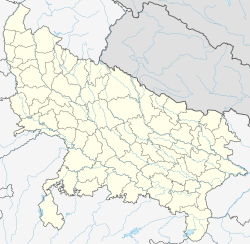world.wikisort.org - India
Naugirwa is a village in Bhetua block of Amethi district, Uttar Pradesh, India.[2] As of 2011, it has a population of 1,168 people, in 220 households.[2] It has one primary school and a veterinary hospital and hosts a weekly haat but not a permanent market.[2] It belongs to the nyaya panchayat of Darai Mafi.[3]
Naugirwa | |
|---|---|
Village | |
 Map showing Naugirwa (#448) in Bhetua CD block | |
 Naugirwa Location in Uttar Pradesh, India | |
| Coordinates: 26.210243°N 81.876708°E[1] | |
| Country | |
| State | Uttar Pradesh |
| Division | Faizabad division |
| District | Amethi |
| Area | |
| • Total | 1.108 km2 (0.428 sq mi) |
| Population (2011)[2] | |
| • Total | 1,168 |
| • Density | 1,100/km2 (2,700/sq mi) |
| Languages | |
| • Official | Hindi, Urdu |
| Time zone | UTC+5:30 (IST) |
The 1951 census recorded Naugirwa as comprising 2 hamlets, with a total population of 303 people (143 male and 160 female), in 64 households and 59 physical houses.[4] 15 residents were literate, all male.[4] The village was listed as belonging to the pargana of Amethi and the thana of Raipur.[4]
The 1961 census recorded Naugirwa as comprising 2 hamlets, with a total population of 334 people (154 male and 180 female), in 74 households and 68 physical houses.[5] The area of the village was given as 306 acres.[5]
The 1981 census recorded Naugirwa as having a population of 509 people, in 99 households, and having an area of 115.74 hectares.[6] The main staple foods were listed as wheat and rice.[6]
The 1991 census recorded Naugirwa as having a total population of 736 people (393 male and 343 female), in 120 households and 118 physical houses.[3] The area of the village was listed as 116.00 hectares.[3] Members of the 0-6 age group numbered 130, or 18% of the total; this group was 57% male (74) and 43% female (56).[3] Members of scheduled castes numbered 101, or 14% of the village's total population, while no members of scheduled tribes were recorded.[3] The literacy rate of the village was 33% (157 men and 44 women, counting only people age 7 and up).[3] 371 people were classified as main workers (206 men and 165 women), while 4 people were classified as marginal workers (all women); the remaining 361 residents were non-workers.[3] The breakdown of main workers by employment category was as follows: 305 cultivators (i.e. people who owned or leased their own land); 34 agricultural labourers (i.e. people who worked someone else's land in return for payment); 0 workers in livestock, forestry, fishing, hunting, plantations, orchards, etc.; 0 in mining and quarrying; 0 household industry workers; 1 worker employed in other manufacturing, processing, service, and repair roles; 0 construction workers; 0 employed in trade and commerce; 3 employed in transport, storage, and communications; and 28 in other services.[3]
References
- "Geonames Search". Do a radial search using these coordinates here.
- "Census of India 2011: Uttar Pradesh District Census Handbook - Sultanpur, Part A (Village and Town Directory)" (PDF). Census 2011 India. pp. 226–42. Retrieved 25 December 2021.
- Census 1991 Series-25 Uttar Pradesh Part-XII B Village & Townwise Primary Census Abstract District Census Handbook District Raebareli (PDF). 1992. pp. xxiv–xxviii, 136–7. Retrieved 25 December 2021.
- Census of India, 1951: District Census Handbook Uttar Pradesh (49 - Rae Bareli District) (PDF). Allahabad. 1955. pp. 100–1. Retrieved 25 December 2021.
- Census 1961: District Census Handbook, Uttar Pradesh (44 - Sultanpur District) (PDF). Lucknow. 1965. pp. xlvi–xlvii. Retrieved 25 December 2021.
- Census 1981 Uttar Pradesh: District Census Handbook Part XIII-A: Village & Town Directory, District Rae Bareli (PDF). 1982. pp. 104–5. Retrieved 25 December 2021.
Другой контент может иметь иную лицензию. Перед использованием материалов сайта WikiSort.org внимательно изучите правила лицензирования конкретных элементов наполнения сайта.
WikiSort.org - проект по пересортировке и дополнению контента Википедии